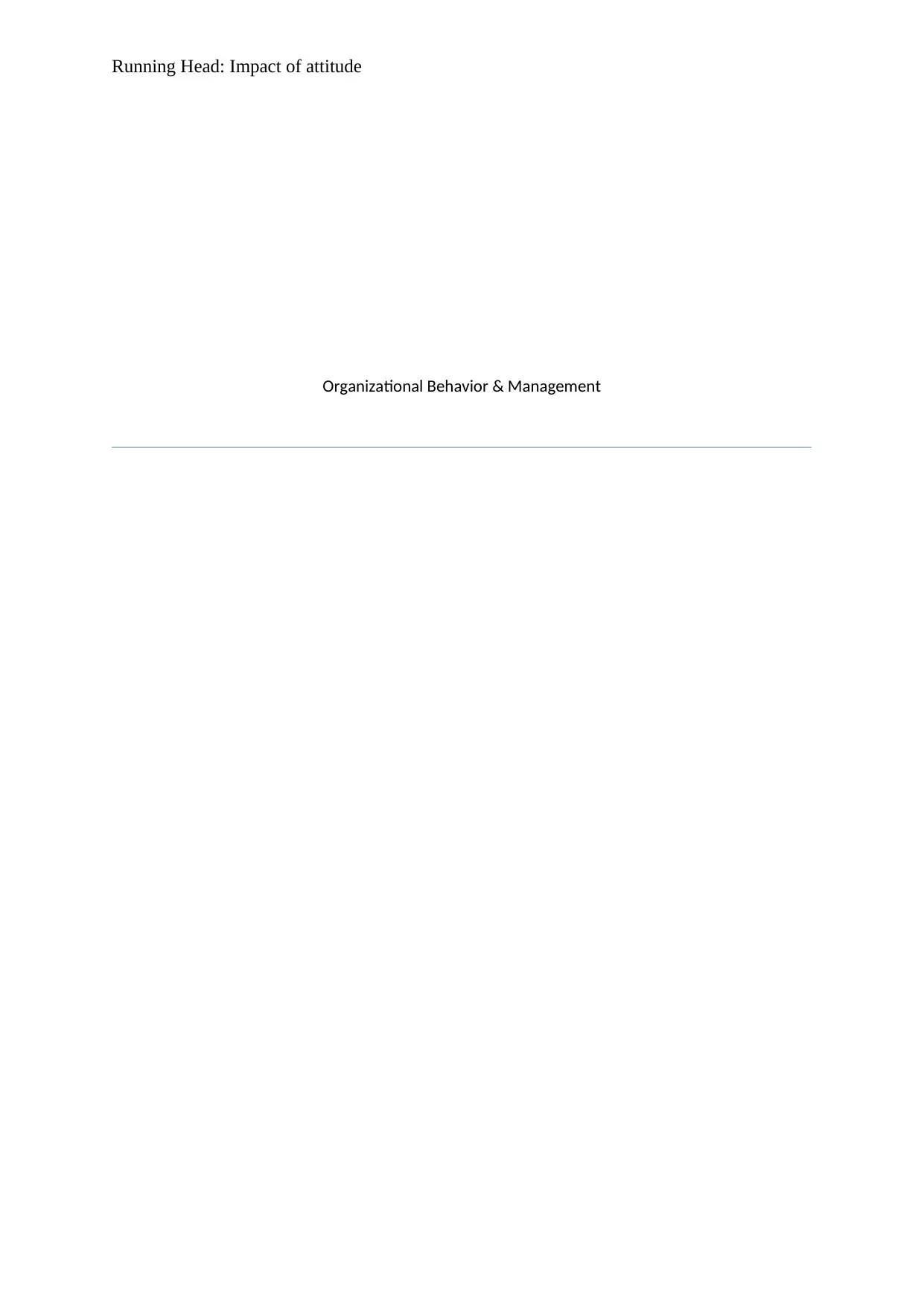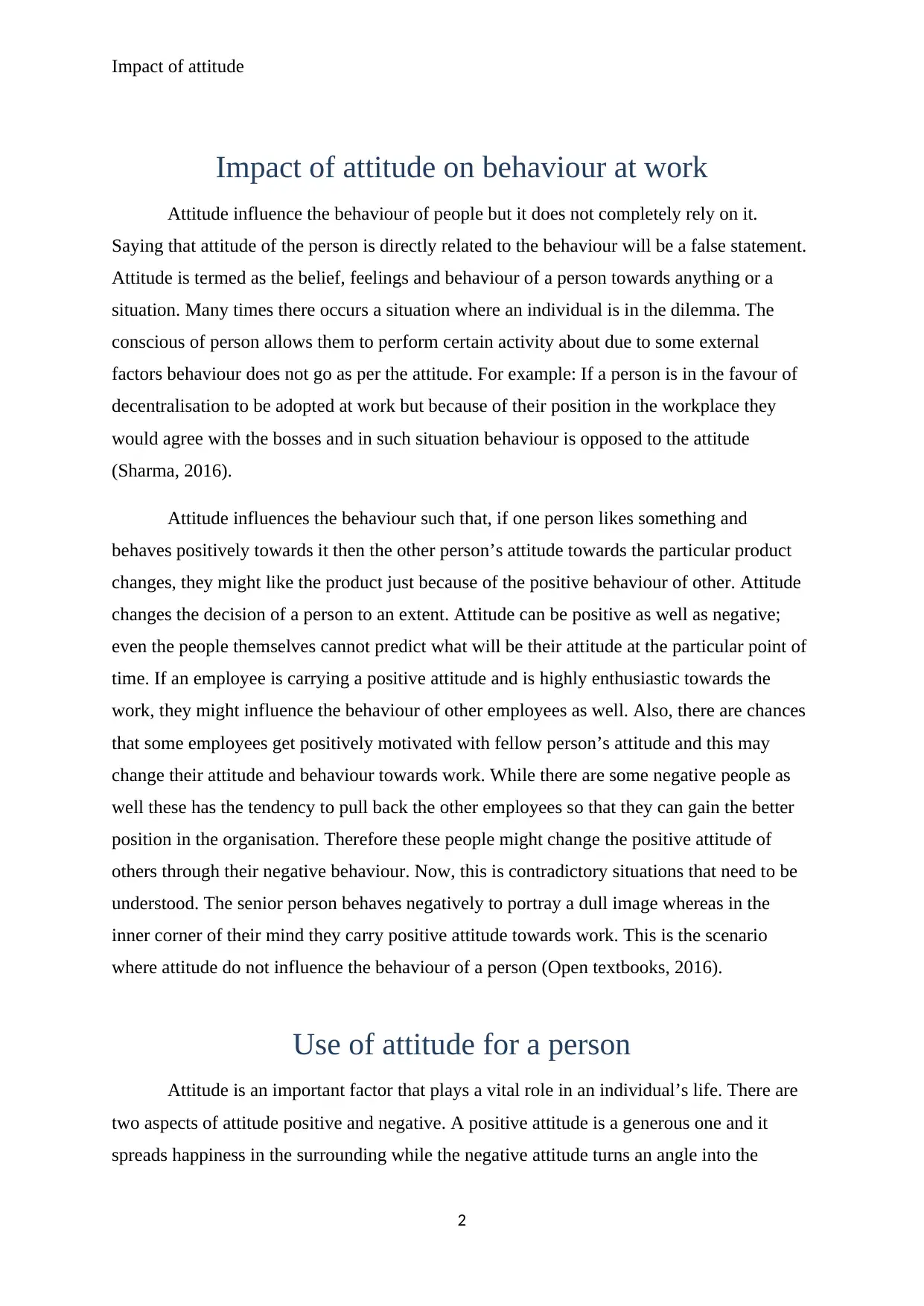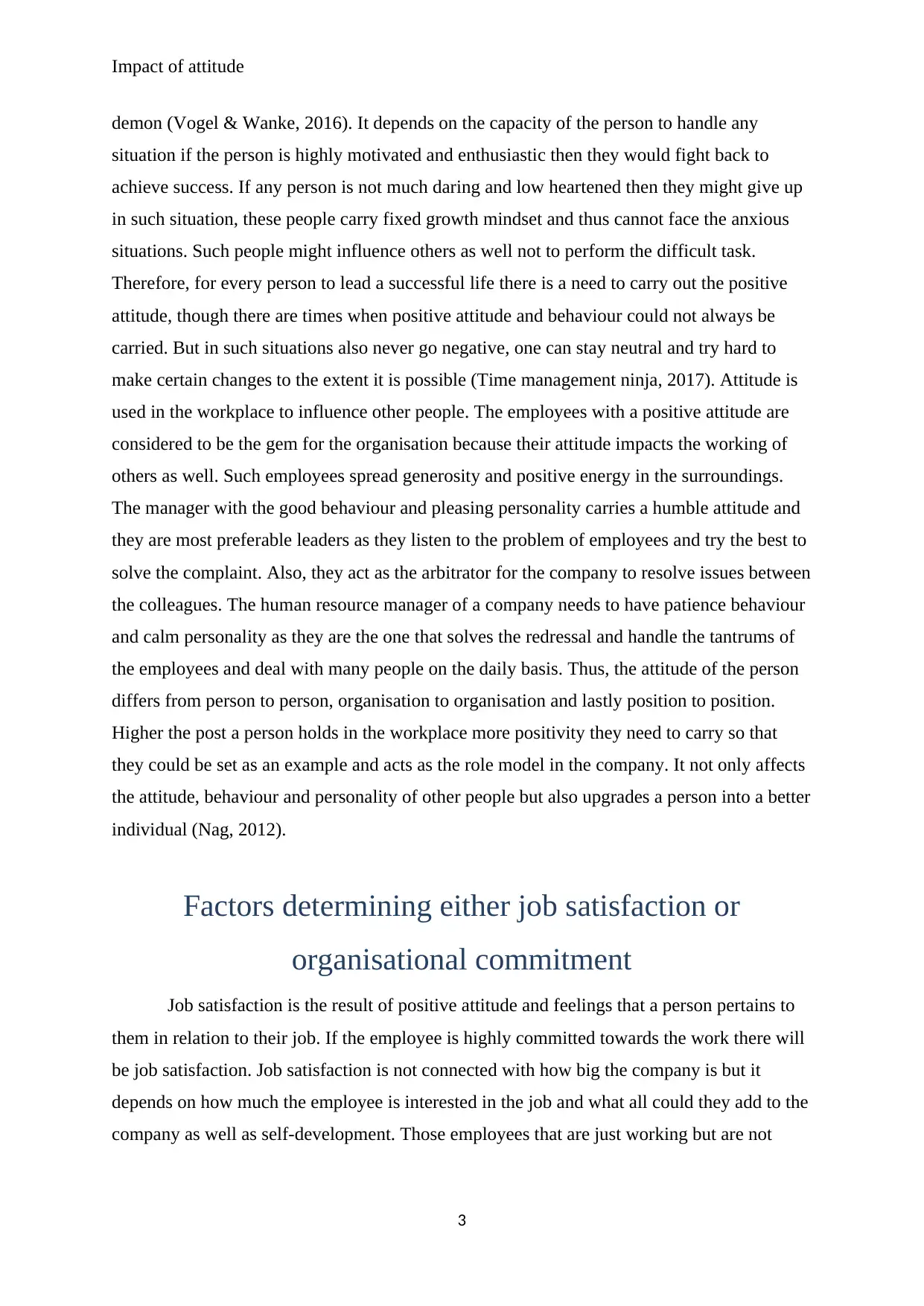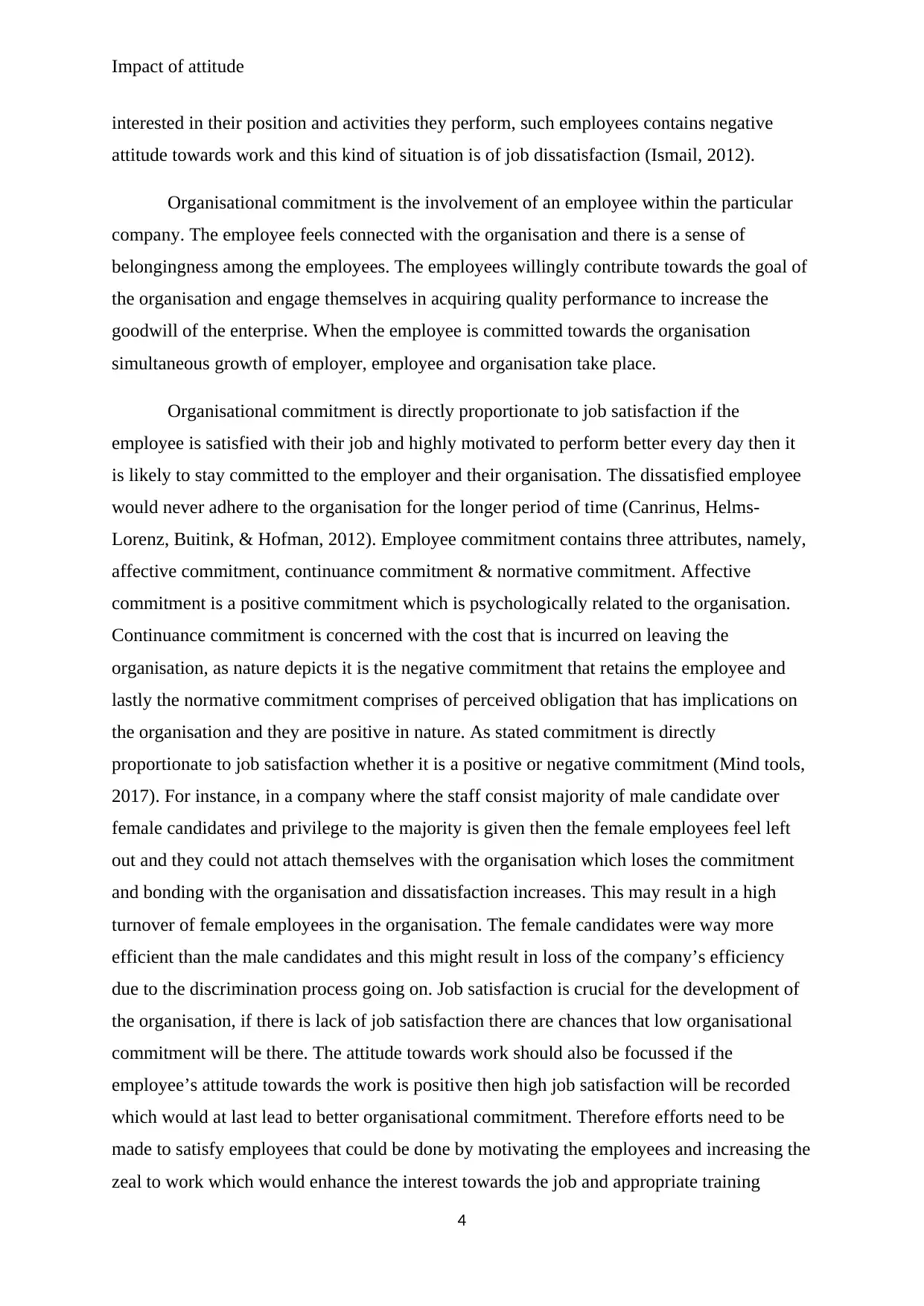Organizational Behavior & Management: Impact of Attitude Report
VerifiedAdded on 2019/11/26
|8
|2154
|383
Report
AI Summary
This report delves into the significant impact of attitude on organizational behavior, exploring its influence on employee actions, job satisfaction, and commitment. It highlights that while attitude influences behavior, it's not the sole determinant, as external factors and workplace dynamics can create discrepancies. The report examines how positive attitudes foster productivity, while negative attitudes can hinder it. It further discusses the role of attitude in personal and professional success, emphasizing the importance of a positive mindset. The report then analyzes the factors determining job satisfaction and organizational commitment, including affective, continuance, and normative commitment. Finally, it underscores the manager's responsibility to cultivate commitment among staff through motivation, training, and creating a supportive work environment, crucial for employee retention and organizational success. The report uses various academic sources to support its claims.

Running Head: Impact of attitude
Organizational Behavior & Management
Organizational Behavior & Management
Paraphrase This Document
Need a fresh take? Get an instant paraphrase of this document with our AI Paraphraser

Impact of attitude
Table of Contents
Impact of attitude on behaviour at work....................................................................................2
Use of attitude for a person........................................................................................................2
Factors determining either job satisfaction or organisational commitment...............................3
Manager’s responsibility to build commitment within the staff................................................5
References..................................................................................................................................5
1
Table of Contents
Impact of attitude on behaviour at work....................................................................................2
Use of attitude for a person........................................................................................................2
Factors determining either job satisfaction or organisational commitment...............................3
Manager’s responsibility to build commitment within the staff................................................5
References..................................................................................................................................5
1

Impact of attitude
Impact of attitude on behaviour at work
Attitude influence the behaviour of people but it does not completely rely on it.
Saying that attitude of the person is directly related to the behaviour will be a false statement.
Attitude is termed as the belief, feelings and behaviour of a person towards anything or a
situation. Many times there occurs a situation where an individual is in the dilemma. The
conscious of person allows them to perform certain activity about due to some external
factors behaviour does not go as per the attitude. For example: If a person is in the favour of
decentralisation to be adopted at work but because of their position in the workplace they
would agree with the bosses and in such situation behaviour is opposed to the attitude
(Sharma, 2016).
Attitude influences the behaviour such that, if one person likes something and
behaves positively towards it then the other person’s attitude towards the particular product
changes, they might like the product just because of the positive behaviour of other. Attitude
changes the decision of a person to an extent. Attitude can be positive as well as negative;
even the people themselves cannot predict what will be their attitude at the particular point of
time. If an employee is carrying a positive attitude and is highly enthusiastic towards the
work, they might influence the behaviour of other employees as well. Also, there are chances
that some employees get positively motivated with fellow person’s attitude and this may
change their attitude and behaviour towards work. While there are some negative people as
well these has the tendency to pull back the other employees so that they can gain the better
position in the organisation. Therefore these people might change the positive attitude of
others through their negative behaviour. Now, this is contradictory situations that need to be
understood. The senior person behaves negatively to portray a dull image whereas in the
inner corner of their mind they carry positive attitude towards work. This is the scenario
where attitude do not influence the behaviour of a person (Open textbooks, 2016).
Use of attitude for a person
Attitude is an important factor that plays a vital role in an individual’s life. There are
two aspects of attitude positive and negative. A positive attitude is a generous one and it
spreads happiness in the surrounding while the negative attitude turns an angle into the
2
Impact of attitude on behaviour at work
Attitude influence the behaviour of people but it does not completely rely on it.
Saying that attitude of the person is directly related to the behaviour will be a false statement.
Attitude is termed as the belief, feelings and behaviour of a person towards anything or a
situation. Many times there occurs a situation where an individual is in the dilemma. The
conscious of person allows them to perform certain activity about due to some external
factors behaviour does not go as per the attitude. For example: If a person is in the favour of
decentralisation to be adopted at work but because of their position in the workplace they
would agree with the bosses and in such situation behaviour is opposed to the attitude
(Sharma, 2016).
Attitude influences the behaviour such that, if one person likes something and
behaves positively towards it then the other person’s attitude towards the particular product
changes, they might like the product just because of the positive behaviour of other. Attitude
changes the decision of a person to an extent. Attitude can be positive as well as negative;
even the people themselves cannot predict what will be their attitude at the particular point of
time. If an employee is carrying a positive attitude and is highly enthusiastic towards the
work, they might influence the behaviour of other employees as well. Also, there are chances
that some employees get positively motivated with fellow person’s attitude and this may
change their attitude and behaviour towards work. While there are some negative people as
well these has the tendency to pull back the other employees so that they can gain the better
position in the organisation. Therefore these people might change the positive attitude of
others through their negative behaviour. Now, this is contradictory situations that need to be
understood. The senior person behaves negatively to portray a dull image whereas in the
inner corner of their mind they carry positive attitude towards work. This is the scenario
where attitude do not influence the behaviour of a person (Open textbooks, 2016).
Use of attitude for a person
Attitude is an important factor that plays a vital role in an individual’s life. There are
two aspects of attitude positive and negative. A positive attitude is a generous one and it
spreads happiness in the surrounding while the negative attitude turns an angle into the
2
⊘ This is a preview!⊘
Do you want full access?
Subscribe today to unlock all pages.

Trusted by 1+ million students worldwide

Impact of attitude
demon (Vogel & Wanke, 2016). It depends on the capacity of the person to handle any
situation if the person is highly motivated and enthusiastic then they would fight back to
achieve success. If any person is not much daring and low heartened then they might give up
in such situation, these people carry fixed growth mindset and thus cannot face the anxious
situations. Such people might influence others as well not to perform the difficult task.
Therefore, for every person to lead a successful life there is a need to carry out the positive
attitude, though there are times when positive attitude and behaviour could not always be
carried. But in such situations also never go negative, one can stay neutral and try hard to
make certain changes to the extent it is possible (Time management ninja, 2017). Attitude is
used in the workplace to influence other people. The employees with a positive attitude are
considered to be the gem for the organisation because their attitude impacts the working of
others as well. Such employees spread generosity and positive energy in the surroundings.
The manager with the good behaviour and pleasing personality carries a humble attitude and
they are most preferable leaders as they listen to the problem of employees and try the best to
solve the complaint. Also, they act as the arbitrator for the company to resolve issues between
the colleagues. The human resource manager of a company needs to have patience behaviour
and calm personality as they are the one that solves the redressal and handle the tantrums of
the employees and deal with many people on the daily basis. Thus, the attitude of the person
differs from person to person, organisation to organisation and lastly position to position.
Higher the post a person holds in the workplace more positivity they need to carry so that
they could be set as an example and acts as the role model in the company. It not only affects
the attitude, behaviour and personality of other people but also upgrades a person into a better
individual (Nag, 2012).
Factors determining either job satisfaction or
organisational commitment
Job satisfaction is the result of positive attitude and feelings that a person pertains to
them in relation to their job. If the employee is highly committed towards the work there will
be job satisfaction. Job satisfaction is not connected with how big the company is but it
depends on how much the employee is interested in the job and what all could they add to the
company as well as self-development. Those employees that are just working but are not
3
demon (Vogel & Wanke, 2016). It depends on the capacity of the person to handle any
situation if the person is highly motivated and enthusiastic then they would fight back to
achieve success. If any person is not much daring and low heartened then they might give up
in such situation, these people carry fixed growth mindset and thus cannot face the anxious
situations. Such people might influence others as well not to perform the difficult task.
Therefore, for every person to lead a successful life there is a need to carry out the positive
attitude, though there are times when positive attitude and behaviour could not always be
carried. But in such situations also never go negative, one can stay neutral and try hard to
make certain changes to the extent it is possible (Time management ninja, 2017). Attitude is
used in the workplace to influence other people. The employees with a positive attitude are
considered to be the gem for the organisation because their attitude impacts the working of
others as well. Such employees spread generosity and positive energy in the surroundings.
The manager with the good behaviour and pleasing personality carries a humble attitude and
they are most preferable leaders as they listen to the problem of employees and try the best to
solve the complaint. Also, they act as the arbitrator for the company to resolve issues between
the colleagues. The human resource manager of a company needs to have patience behaviour
and calm personality as they are the one that solves the redressal and handle the tantrums of
the employees and deal with many people on the daily basis. Thus, the attitude of the person
differs from person to person, organisation to organisation and lastly position to position.
Higher the post a person holds in the workplace more positivity they need to carry so that
they could be set as an example and acts as the role model in the company. It not only affects
the attitude, behaviour and personality of other people but also upgrades a person into a better
individual (Nag, 2012).
Factors determining either job satisfaction or
organisational commitment
Job satisfaction is the result of positive attitude and feelings that a person pertains to
them in relation to their job. If the employee is highly committed towards the work there will
be job satisfaction. Job satisfaction is not connected with how big the company is but it
depends on how much the employee is interested in the job and what all could they add to the
company as well as self-development. Those employees that are just working but are not
3
Paraphrase This Document
Need a fresh take? Get an instant paraphrase of this document with our AI Paraphraser

Impact of attitude
interested in their position and activities they perform, such employees contains negative
attitude towards work and this kind of situation is of job dissatisfaction (Ismail, 2012).
Organisational commitment is the involvement of an employee within the particular
company. The employee feels connected with the organisation and there is a sense of
belongingness among the employees. The employees willingly contribute towards the goal of
the organisation and engage themselves in acquiring quality performance to increase the
goodwill of the enterprise. When the employee is committed towards the organisation
simultaneous growth of employer, employee and organisation take place.
Organisational commitment is directly proportionate to job satisfaction if the
employee is satisfied with their job and highly motivated to perform better every day then it
is likely to stay committed to the employer and their organisation. The dissatisfied employee
would never adhere to the organisation for the longer period of time (Canrinus, Helms-
Lorenz, Buitink, & Hofman, 2012). Employee commitment contains three attributes, namely,
affective commitment, continuance commitment & normative commitment. Affective
commitment is a positive commitment which is psychologically related to the organisation.
Continuance commitment is concerned with the cost that is incurred on leaving the
organisation, as nature depicts it is the negative commitment that retains the employee and
lastly the normative commitment comprises of perceived obligation that has implications on
the organisation and they are positive in nature. As stated commitment is directly
proportionate to job satisfaction whether it is a positive or negative commitment (Mind tools,
2017). For instance, in a company where the staff consist majority of male candidate over
female candidates and privilege to the majority is given then the female employees feel left
out and they could not attach themselves with the organisation which loses the commitment
and bonding with the organisation and dissatisfaction increases. This may result in a high
turnover of female employees in the organisation. The female candidates were way more
efficient than the male candidates and this might result in loss of the company’s efficiency
due to the discrimination process going on. Job satisfaction is crucial for the development of
the organisation, if there is lack of job satisfaction there are chances that low organisational
commitment will be there. The attitude towards work should also be focussed if the
employee’s attitude towards the work is positive then high job satisfaction will be recorded
which would at last lead to better organisational commitment. Therefore efforts need to be
made to satisfy employees that could be done by motivating the employees and increasing the
zeal to work which would enhance the interest towards the job and appropriate training
4
interested in their position and activities they perform, such employees contains negative
attitude towards work and this kind of situation is of job dissatisfaction (Ismail, 2012).
Organisational commitment is the involvement of an employee within the particular
company. The employee feels connected with the organisation and there is a sense of
belongingness among the employees. The employees willingly contribute towards the goal of
the organisation and engage themselves in acquiring quality performance to increase the
goodwill of the enterprise. When the employee is committed towards the organisation
simultaneous growth of employer, employee and organisation take place.
Organisational commitment is directly proportionate to job satisfaction if the
employee is satisfied with their job and highly motivated to perform better every day then it
is likely to stay committed to the employer and their organisation. The dissatisfied employee
would never adhere to the organisation for the longer period of time (Canrinus, Helms-
Lorenz, Buitink, & Hofman, 2012). Employee commitment contains three attributes, namely,
affective commitment, continuance commitment & normative commitment. Affective
commitment is a positive commitment which is psychologically related to the organisation.
Continuance commitment is concerned with the cost that is incurred on leaving the
organisation, as nature depicts it is the negative commitment that retains the employee and
lastly the normative commitment comprises of perceived obligation that has implications on
the organisation and they are positive in nature. As stated commitment is directly
proportionate to job satisfaction whether it is a positive or negative commitment (Mind tools,
2017). For instance, in a company where the staff consist majority of male candidate over
female candidates and privilege to the majority is given then the female employees feel left
out and they could not attach themselves with the organisation which loses the commitment
and bonding with the organisation and dissatisfaction increases. This may result in a high
turnover of female employees in the organisation. The female candidates were way more
efficient than the male candidates and this might result in loss of the company’s efficiency
due to the discrimination process going on. Job satisfaction is crucial for the development of
the organisation, if there is lack of job satisfaction there are chances that low organisational
commitment will be there. The attitude towards work should also be focussed if the
employee’s attitude towards the work is positive then high job satisfaction will be recorded
which would at last lead to better organisational commitment. Therefore efforts need to be
made to satisfy employees that could be done by motivating the employees and increasing the
zeal to work which would enhance the interest towards the job and appropriate training
4

Impact of attitude
program will automatically attach the commitment towards the organisation (Brunetto, Teo,
& Farr-Wharton, 2012).
Manager’s responsibility to build commitment within
the staff
Commitment within the staff could be constructed when the employees are motivated
and influenced by the managers to work smart. Though in today’s technological scenario
there are machines that perform half of the work effectively and efficiently still the human
resources are the asset for an organisation. Human resources can never be replaced by any
machine, it could reduce the time and quality but cannot replace the work that is been
accomplished by the employees (Adham, 2017). The thing is employees are not much related
to their work and perform 20-80% of the capacity and if they become determined they are
likely to attain heights they can achieve the 100% efficiency. It is observed when the senior
manager or owner is near the area of workplace efficient working goes on, which if continued
daily who led the organisation to the new heights ahead of the competitors. It is the
responsibility of the manager to employ the motivational theory to retain the employees and
increase the commitment. Thus, it could be done by imparting timely training and following
Herzberg two factor theory where job satisfaction and motivational activity go along
simultaneously. Through appreciation and challenging activities employees feel engaged in
the employee, there is a sense of belief and faith that employer would render something better
and will make them learn along to move along. Through this group, the spirit gets activated
and employees move at height taking along the organisation as a whole. Such efforts pay
back to the company in the form of organisational commitment and employee turnover
decreases with the increase in job satisfaction (Centerod, 2012).
References
Adham. A., 2017, ‘Employee involvement and its impact on job satisfaction and
organisational commitment’, International Journal of Sciences: Basic and Applied Research,
vol.35, no. 3, p.p. 368-400.
5
program will automatically attach the commitment towards the organisation (Brunetto, Teo,
& Farr-Wharton, 2012).
Manager’s responsibility to build commitment within
the staff
Commitment within the staff could be constructed when the employees are motivated
and influenced by the managers to work smart. Though in today’s technological scenario
there are machines that perform half of the work effectively and efficiently still the human
resources are the asset for an organisation. Human resources can never be replaced by any
machine, it could reduce the time and quality but cannot replace the work that is been
accomplished by the employees (Adham, 2017). The thing is employees are not much related
to their work and perform 20-80% of the capacity and if they become determined they are
likely to attain heights they can achieve the 100% efficiency. It is observed when the senior
manager or owner is near the area of workplace efficient working goes on, which if continued
daily who led the organisation to the new heights ahead of the competitors. It is the
responsibility of the manager to employ the motivational theory to retain the employees and
increase the commitment. Thus, it could be done by imparting timely training and following
Herzberg two factor theory where job satisfaction and motivational activity go along
simultaneously. Through appreciation and challenging activities employees feel engaged in
the employee, there is a sense of belief and faith that employer would render something better
and will make them learn along to move along. Through this group, the spirit gets activated
and employees move at height taking along the organisation as a whole. Such efforts pay
back to the company in the form of organisational commitment and employee turnover
decreases with the increase in job satisfaction (Centerod, 2012).
References
Adham. A., 2017, ‘Employee involvement and its impact on job satisfaction and
organisational commitment’, International Journal of Sciences: Basic and Applied Research,
vol.35, no. 3, p.p. 368-400.
5
⊘ This is a preview!⊘
Do you want full access?
Subscribe today to unlock all pages.

Trusted by 1+ million students worldwide

Impact of attitude
Brunetto, Y., Teo, S.T., Shacklock, K. and Farr‐Wharton, R., 2012, Emotional intelligence,
job satisfaction, well‐being and engagement: explaining organisational commitment and
turnover intentions in policing Human Resource Management Journal, vol. 22, no.4, pp.428-
441.
Canrinus, E.T., Helms-Lorenz, M., Beijaard, D., Buitink, J. and Hofman, A., 2012, ‘Self-
efficacy, job satisfaction, motivation and commitment: Exploring the relationships between
indicators of teachers’ professional identity’, European journal of psychology of education,
vol.27, no. 1, pp.115-132.
Centerod, 2012, Seven ideas to get the most from your people, viewed on 7th September 2017,
< http://www.centerod.com/2012/02/getting-most-from-people/>.
Ismail, N., 2012, organisational commitment and job satisfaction among staff of higher
learning education institutions in Kelantan, viewed on 7th September 2017,
<http://etd.uum.edu.my/3003/1/Norizan_Ismail.pdf>.
Mind tools, 2017, The three component model of commitment, viewed on 7th September 2017,
< https://www.mindtools.com/pages/article/three-component-model-commitment.htm>.
Nag. A., 2012, Significance of a positive attitude in the workplace, viewed on 7th September
2017, < http://blog.commlabindia.com/elearning-design/positive-attitude-at-workplace>.
Open textbooks for Hong Kong, 2016, When do our attitudes guide our behaviour? Viewed
on 7th September 2017, < http://www.opentextbooks.org.hk/ditatopic/16184>.
Pascual. J. S., 2015, Why attitude is the most important thing in success, viewed on 7th
September 2017, < https://thoughtcatalog.com/jeanne-san-pascual/2015/02/why-attitude-is-
the-most-important-thing-in-success/>.
Sharma. A., 2016, How attitude influences our behaviour- answered! Viewed on 7th
September 2017, < http://www.psychologydiscussion.net/essays/how-attitude-influences-our-
behaviour/698>.
Time management ninja, 2017, 21 ways to define a positive attitude, viewed on 7th
September 2017, < https://timemanagementninja.com/2012/02/21-ways-to-define-a-positive-
attitude/>.
Vogel, T. and Wanke, M., 2016, Attitudes and attitude change, Routledge, New York.
6
Brunetto, Y., Teo, S.T., Shacklock, K. and Farr‐Wharton, R., 2012, Emotional intelligence,
job satisfaction, well‐being and engagement: explaining organisational commitment and
turnover intentions in policing Human Resource Management Journal, vol. 22, no.4, pp.428-
441.
Canrinus, E.T., Helms-Lorenz, M., Beijaard, D., Buitink, J. and Hofman, A., 2012, ‘Self-
efficacy, job satisfaction, motivation and commitment: Exploring the relationships between
indicators of teachers’ professional identity’, European journal of psychology of education,
vol.27, no. 1, pp.115-132.
Centerod, 2012, Seven ideas to get the most from your people, viewed on 7th September 2017,
< http://www.centerod.com/2012/02/getting-most-from-people/>.
Ismail, N., 2012, organisational commitment and job satisfaction among staff of higher
learning education institutions in Kelantan, viewed on 7th September 2017,
<http://etd.uum.edu.my/3003/1/Norizan_Ismail.pdf>.
Mind tools, 2017, The three component model of commitment, viewed on 7th September 2017,
< https://www.mindtools.com/pages/article/three-component-model-commitment.htm>.
Nag. A., 2012, Significance of a positive attitude in the workplace, viewed on 7th September
2017, < http://blog.commlabindia.com/elearning-design/positive-attitude-at-workplace>.
Open textbooks for Hong Kong, 2016, When do our attitudes guide our behaviour? Viewed
on 7th September 2017, < http://www.opentextbooks.org.hk/ditatopic/16184>.
Pascual. J. S., 2015, Why attitude is the most important thing in success, viewed on 7th
September 2017, < https://thoughtcatalog.com/jeanne-san-pascual/2015/02/why-attitude-is-
the-most-important-thing-in-success/>.
Sharma. A., 2016, How attitude influences our behaviour- answered! Viewed on 7th
September 2017, < http://www.psychologydiscussion.net/essays/how-attitude-influences-our-
behaviour/698>.
Time management ninja, 2017, 21 ways to define a positive attitude, viewed on 7th
September 2017, < https://timemanagementninja.com/2012/02/21-ways-to-define-a-positive-
attitude/>.
Vogel, T. and Wanke, M., 2016, Attitudes and attitude change, Routledge, New York.
6
Paraphrase This Document
Need a fresh take? Get an instant paraphrase of this document with our AI Paraphraser

Impact of attitude
7
7
1 out of 8
Related Documents
Your All-in-One AI-Powered Toolkit for Academic Success.
+13062052269
info@desklib.com
Available 24*7 on WhatsApp / Email
![[object Object]](/_next/static/media/star-bottom.7253800d.svg)
Unlock your academic potential
Copyright © 2020–2025 A2Z Services. All Rights Reserved. Developed and managed by ZUCOL.





